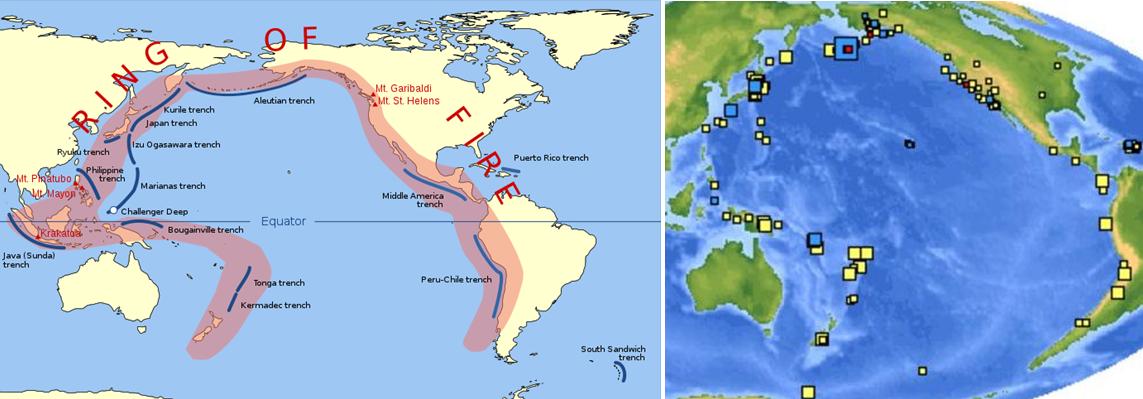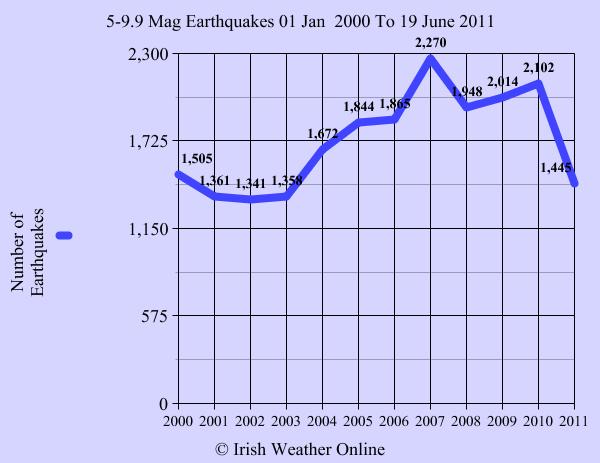A 7.2 magnitude earthquake (revised down from 7.4 by the USGS) in Alaska, USA, late Thursday was the latest in a series of strong earthquakes to hit nations located along the Pacific Ring of Fire during the past week.
Among the other nations to record moderate to strong earthquakes this week include Japan, Fiji, Panama, Papua New Guinea, Indonesia, Costa Rica, Solomon Islands, Vanuatu, Tonga, Samoa, Chile, Peru, Bolivia, Argentina and Antarctica.
The "Ring of Fire" is an arc stretching from New Zealand, along the eastern edge of Asia, north across the Aleutian Islands of Alaska, and south along the coast of North and South America. The Ring of Fire is composed over 75% of the world's active and dormant volcanoes.

© WIKI / USGSPacific Ring of Fire and the earthquakes from the last 7 days.
The
US Geological Survey (USGS) confirmed that a quake measuring 7.2 on the Richter Scale hit the sparsely populated Fox Islands region of the Aleutian Islands. Thursday night. The epicentre, recorded at a depth of 62km, was located 64 km (39 miles) SW of Amukta Island, 103 km (64 miles) SW of Yunaska Island, and 1677 km (1042 miles) WSW of Anchorage, Alaska's largest city. The quake hit just two days after a 5.1 magnitude earthquake hit the Rat Islands region.
There were no immediate reports of injuries or significant structural damage from Thursday night's earthquake. A tsunami warning issued for the west coast of North America from the Mexican border to Alaska soon after the quake struck was later cancelled.
Four earthquakes measuring in excess of 5.0 on the Richter Scale struck Alaska last week. A magnitude 5.1 earthquake hit at 8PM (11AM local time, Thursday 16 May). It's epicentre was located 110km southwest of the State's largest city Anchorage, 16km east of Nikiski (population 4327) in the Kenai Peninsula Borough, and 28 km northeast of Kenai (population 7464). The quake was recorded at a depth of 70km. Three moderate quakes, two 5.1 magnitude quakes and a 5.2 magnitude quake, followed at 8.06PM. At least three earth tremors measuring 2-3 magnitude were recorded in the same area five minutes later. The Alaska Earthquake Information Center said the event was widely felt in the Kenai Peninsula and Cook Inlet regions. The strongest shaking was experienced in the Peninsula communities of Sterling and Soldotna.
Other Quakes on the Pacific Ring of FireA large earthquake (magnitude 6.7) struck off the coast of Honshu, Japan, Wednesday night prompting authorities to issue a tsunami alert for the northeast of the country. The quake epicentre was located 86 km (53 miles) SE (132°) from Hachinohe, Honshu, 100 km (62 miles) ENE (73°) from Morioka, Honshu, Japan, 161 km (100 miles) SE (126°) from Aomori, Honshu, and 527 km (328 miles) NNE (24°) from Tokyo.
A series of large tremors measuring greater than 5 on the Richter Scale have been recorded since Wednesday night's earthquake, the latest a magnitude 5.2 Thursday night. It was located 173 km (107 miles) SSE of Kagoshima, Kyushu, Japan. Hour earlier a 5.3 quake struck close to the tsunami-stricken port city of Sendai. Japan is still reeling from the March 11 9 magnitude earthquake and tsunami which devastated parts of the north east.
Elsewhere, a 6.2 magnitude earthquake struck The Solomon Islands in the south-western Pacific Ocean Friday morning. The strong quake was centred 25 km (15 miles) SSE of the provincial capital of the Santa Cruz Islands and 444 km (275 miles) E of Kira Kira, San Cristobal. According to the US Geological Survey the quake was recorded at a depth of 62.6 km (38.9 miles). It was the third strong earthquake to his the region this week. A 6.1 quake was recorded 93 km (57 miles) SSW of Lata on Tuesday morning while a 5.5 magnitude quake hit between the Santa Cruz Islands and Vanuatu on Monday evening.
The Santa Cruz Islands are part of Temotu Province of the Solomon Islands. They lie approximately 250 miles (400 km) to the southeast of the Solomon Islands Chain. The Santa Cruz Islands lie just north of the archipelago of Vanuatu, and are considered part of the Vanuatu rain forests ecoregion.
On Thursday night Tonga was hot by a moderate earthquake, which was recorded 102 km (63 miles) NNE of Hihifo and 229 km (142 miles) SW of Apia, Samoa.
On Wednesday night a magnitude 5.2 earthquake was recorded 126 km (78 miles) SSW of Ndoi Island, Fiji. The region was also hit by 5.5 and 5.1 magnitude quakes on Saturday and Sunday respectively.
The Catamarca region of Argentina also experienced a moderate earthquake on Wednesday afternoon. The 5.3 magnitude quake was centred 66 km (41 miles) SE of Belen, Catamarca, and 160 km (99 miles) NNE of La Rioja.
A 5.2 magnitude quake struck the South Island of New Zealand at 10.34 PM (local) on Tuesday. The quake epicentre was located 7km from Christchurch, which has been shaken by thousands of aftershocks since the February 22 quake that killed 181. Earlier on Tuesday the Kermadec Islands Region of New Zealand experienced a magnitude 5 earthquake.
Also on Tuesday, northern Sumatra in Indonesia was shaken by a magnitude 5.2 tremor, located 109 km south of the city of Padang (population 840,352).
A strong earthquake struck the Antofagasta region of Chile Monday afternoon. The epicentre was located 87 km (54 miles) NE of Calama, Antofagasta, and 224 km (139 miles) SW of Uyuni, Bolivia.
A 5.4 magnitude quake hit the small south-western Pacific island nation of Vanuatu on Monday. The earthquake was centred 70 km NW of the town of Sola.
On Sunday a 5.1 magnitude earthquake struck 135 km (83 miles) south of David, Panama and 184 km (114 miles) SSE of Golfito, Costa Rica.
A 4.9 magnitude quake was recorded along the Pacific-Antarctic Ridge On Sunday afternoon, while a magnitude 5.1 tremor was also recorded in the Balleny Islands region, 479 km (297 miles) NW of Scott Island, on Saturday.
On Saturday night the northern coast of Peru experienced a moderate 5 magnitude earthquake which was felt 91 km away in the city of Piura.
On Saturday morning a magnitude 5.2 tremor was recorded in eastern New Guinea region of Papua New Guinea. The quake struck 66 km (41 miles) NW of Lae and 355 km (220 miles) NNW of Port Moresby.
AnalysisEarlier this week Irish Weather Online reported that 2011 is on target to record the largest number of earthquakes in a single year for at least 12 years.
Research by Irish Weather Online, using data from the US Geological Survey (USGS), has found that earthquake activity (5.0-9.9 magnitude) from 01 January to 19 June 2011 is already exceeding the total annual seismic activity for the years 2001, 2002 and 2003. 2011's total number of recorded earthquakes is also expected to exceed the most seismically active year of the past 12 years, 2007.
A total of 1,445 earthquakes, ranging in magnitude from 5.0 to 9.9, have been recorded in the year up to 19 June. The total number of earthquakes recorded globally for the entire of 2007 was 2,270.

© Irish Weather Online
The massive earthquakes in Japan (2011), Chile (2010), Sichuan (2008), Sumatra (2005 and 2008) and Indonesia (2004) have served to remind us of the devastating impact of earthquakes on life and property. While the number of earthquakes ranging between 8.0 magnitude and 9.9 magnitude have shown no significant increases in recent years, the number of earthquakes ranging 5.0 magnitude to 7.9 magnitude is rising. In particular there has been a sharp rise during the past 12 years of moderate earthquakes in the range 5-6.9.
While considered moderate to strong on the Richter Scale and far less severe than 7+ magnitude quakes, earthquakes in this range can still cause widespread damage and loss of life. Some well known examples include Haiti in 2010 (7 mag), San Francisco Bay, California, USA, in 1989 (6.9 mag), Caracas, Venezuela, in 1965 (6.5 mag), Christchurch, New Zealand, in 2011 (6.3 mag), L'Aquila, Italy in 2009 (5.8 mag), and Newcastle , Australia, in 1989 (5.6 mag).
Seismologists argue that an increase in detected earthquakes does not necessarily represent an increase in actual earthquakes. The USGS, for example, says improved global communication and enhancements in detection technology have both contributed to higher earthquake numbers being recorded over time.
According to the USGS: "Although it may seem that we are having more earthquakes, earthquakes of magnitude 7.0 or greater have remained fairly constant throughout this century and, according to our records, have actually seemed to decrease in recent years."
Commenting on swarm earth activity in a specific geographical area, the USGS said :" A temporal increase in earthquake activity does not mean that a large earthquake is about to happen. Similarly, quiescence, or the lack of seismicity, does not mean a large earthquake is going to happen. A temporary increase or decrease in the seismicity rate is usually just part of the natural variation in the seismicity. There is no way for us to know whether or not this time it will lead to a larger earthquake. Swarms of small events, especially in geothermal areas, are common, and moderate-large magnitude earthquakes will typically have an aftershock sequence that follows. All that is normal and expected earthquake activity."
References:
USGS
EMSC
WIKI
Reader Comments
to our Newsletter